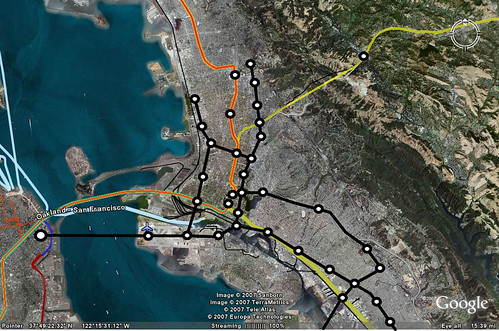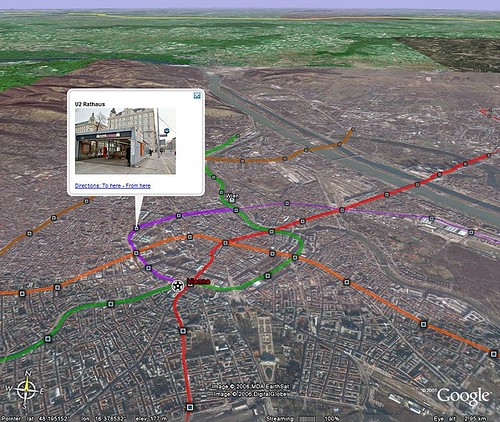Some thoughts before I read it though based on what I've read in Richard's posts and my own evolution in thinking.
I had a bit of a thought today that should have come together sooner but I was looking over Google Earth at a way to connect commuter rail/HSR directly to downtown San Jose instead of the current just outside of downtown location of Diridon station. It seems to me that what is needed in each city around the bay is a local metro that moves people quickly around the central city. Each of these metros can be connected by commuter rail lines like Caltrain along commuter corridors but the most beneficial systems will be those that serve future density, not just existing transit.
I started writing this post before going to Washington with the hope that on the plane I could make some maps. The good part is that the trip reaffirmed what I wanted to back up. That an in town metro is important to vibrancy and movement in a city. Serving the suburbs should be done, but the way we are going to make our transit systems work is with good circulation in the center to build up core density. If we could see where Washington DC was before Metro and where it is now, you would see a huge difference in the city. If the current naysayers were around then to kill projects, that project would have never been built, and the city would look very different.
But other cities should look to the future in the same way. The future benefits outweigh current costs and with more people preferring to live a city life, its got an increased benefit of soaking up growth that would usually cause gross distortions in where people live and work. This is the option of urbanism like Chris Leinberger says.
So we'll start at Oakland. Previously I made a fantasy map for an Oakland Metro that you see directly below.

This was based on getting people in and out of a city, and not really a core urban strategy. I realize that now, but when you compare it some of the Subway systems that work really well it doesn't really look quite right.
Vienna's Metro looks different. There are a number of lines that criss cross a number of ways. The same with the Washington Metro.

 With that being said, here's a more core system. I've come up with these for San Francisco, Oakland and San Jose as the major regional centers but am thinking about doing other cities as well. The Space Race focuses so much on suburban serving transit that the core again is left out. But perhaps this is the way we should rethink it. We'll start with Oakland.
With that being said, here's a more core system. I've come up with these for San Francisco, Oakland and San Jose as the major regional centers but am thinking about doing other cities as well. The Space Race focuses so much on suburban serving transit that the core again is left out. But perhaps this is the way we should rethink it. We'll start with Oakland.
Now all of these maps will be at the same scale for the Bay Area. The circles are about 5 miles across and show a primary core that could densify in corridors and the core soaking up a lot of housing need and with less energy usage from density, walkable neighborhoods, and easier access to close districts.
Now I'm not sure that this necessarily needs to be a Metro Subway. It could be a dedicated lane streetcar or light rail. However a subway can go from end to end without having to stop at a light and stay on schedule with faster speeds. This facilitates use. But it might work in a smaller city with a smaller sphere than the five miles for core circulation. We should think about these implications and ask, what will get us the most riders and most future benefit instead of just thinking about cost and as I've mentioned before just bringing people into the center of the city.

4 comments:
Just note that I will claim ownership for an extension of Belmont's points, probably the only thing I figured out that he did not.
He writes about SF specifically in contrast to BART, but he doesn't see the linked potential of the systems in quite the same way as I do.
Similarly, he criticizes, justifiably, the WMATA system as being polycentric. However, he fails to take into consideration how the system operates in that core area within DC.
I argue that it operates monocentrically, promoting the recentralization of housing and commerce as he advocates.
Getting to your post and points, this is why jurisdictions within regions need to have their own transportation plans.
And why regions need to better specify their transit network(s).
http://urbanplacesandspaces.blogspot.com/2008/05/thinking-about-transit-network.html
P.S. I wish I would've known you were coming to DC. There is something I need to talk to you about.
Ok guys, next you have to read Don Shoup's "The High Cost of Free Parking." It can be tedious at times, but if you don't understand what he is talking about then all the METROs in the world won't solve our problems.
Of course Ken, that's absolutely right. The parking issue is huge. I noticed also in a piece written by U of Minn professor Gary Barnes that his findings on transit and employment specify the importance of parking policy as well. We'll put it all together, but for now I just wanted to talk about core transit systems.
i disagree with your point about diridon station. I realize it isn't quite as built up as the rest of downtown san jose. However, it does have a hockey stadium, and of course, the potential to grow more (although I'm not sure if the airport's proximity limits certain vertical growth.) If anything, Diridon could be made "closer" to downtown San Jose, perhaps by speeding up the light rail, which has to contend with on-street traffic and tight turns down there. SF should heed that warning too, since Muni could also be sped up significantly (I guess that's what the TEP will do.) I'm not sure how much the BART station will help, but some predict that it'll connect to Diridon:
http://www.cahighspeedrail.ca.gov/gallery.aspx (see the San Jose station simulation)
As far as Oakland is concerned, I doubt we'd ever see the return of the Key System. However, there are efforts to implement BRT there.
Post a Comment